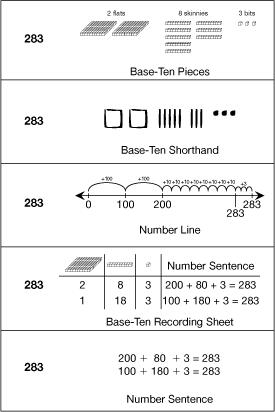This Workshop gives students an opportunity to improve their flexibility and confidence with different representations and partitions of a number. Students revisit trading, compare different representations of numbers to solve problems, represent the partitions of a number using a number sentence, and practice reading and writing large numbers.
Content in this Lesson
- Composing and decomposing numbers using ones, tens, hundreds, and thousands [E2].
- Showing different partitions of numbers using base-ten pieces, number lines, and number sentences [E3].
- Recognizing that different partitions of a number have the same total (e.g., 100 + 20 + 3 = 100 + 10 + 13) [E4].
- Reading and writing larger numbers to the thousands [E5].
- Comparing large numbers to the thousands [E6].
Daily Practice and Problems O–T
P. More Multiplication Stories
Q. Number of Students in School
Assessment in this Lesson
| Assessment | Expectation Assessed |
|---|---|
|
Workshop: Place Value |
|
|
Place Value with Feedback Box |
|
|
DPP Item P |
|
|
DPP Item S |
|



















